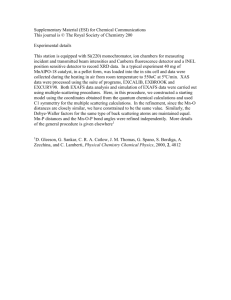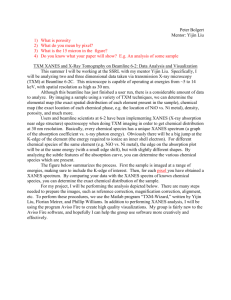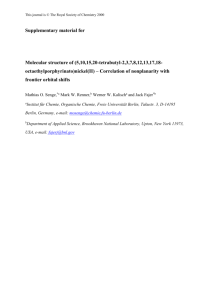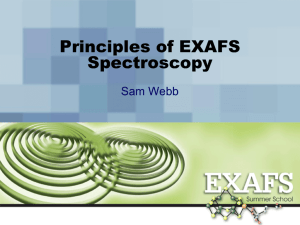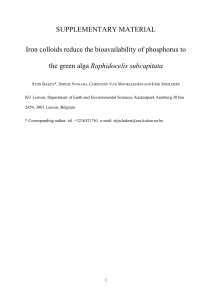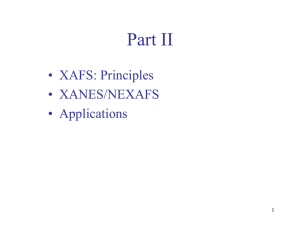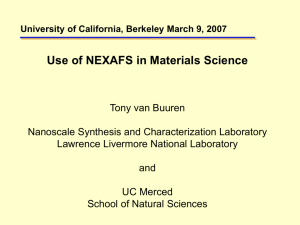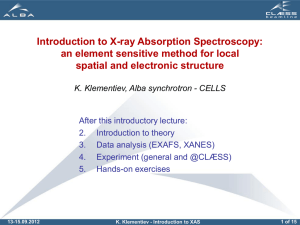MS PowerPoint
advertisement
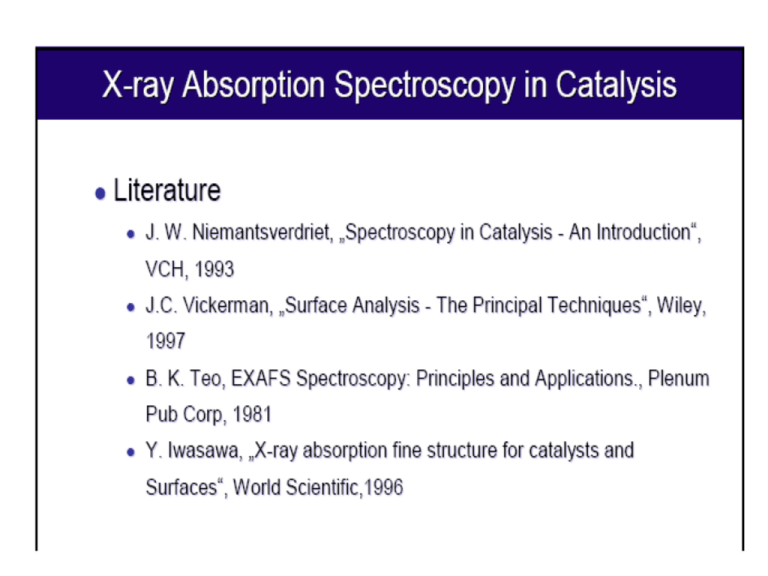
Information content: EXAFS, SEXAFS: Bond lengths. Especially useful because these technique probe the local order. While diffraction methods require crystallinity, EXAFS/SEXAFS can be applied to amorphous materials. EXAFS typically measures the absorption of X-rays or possibly X-ray fluorescence. SEXAFS uses the Auger electrons emitted, and therefore is surface-sensitive because of the short escape depth. A second useful features of EXAFS/SEXAFS is that one can tune to a specific absorption edge of a material of interest. So, for studying various dopants (for example) that might be present in fairly low concentrations, it is still possible to study them by tuning to an absorption edge of the atom of interest. NEXAFS (XANES) focuses on the near-edge structure, which is very sensitive to the valence-band hybridization. It is difficult to interpret quantitatively, but is good for looking at the local bonding around atoms, especially for non-crystalline materials. NEXAFS XANES Spectra are very sensitive to oxidation state (like XPS) and also to local coordination environment Interpretation of XANES spectra is quite difficult due to breakdown of EXAFS equation at small k and the increase in electron mean-free path at low energy Why are X-ray absorption peaks asymmetric ?? 2k 2 E 2m Free electron dE 2 k dk m dk 1 m 2 dE dE k dk Density of states: This is the number of allowed “k” states per unit interval of energy dk 1 m dE dE 2m E dk X-ray absorption peaks are asymmetric because the final state electron can have a large number of different kinetic energies. There are many final states that have kinetic energy near zero, but only a few states at high energy. E here refers to the kinetic energy of the electron; so the absorption coefficient has a dependence like (1/sqrt(E-E0)) where E0 is the absorption edge. XANES = NEXAFS: Looks at oscillations within ~300 eV of edge EXAFS: Looks at oscillations more than ~300 eV of edge Incident wave 1 Incident wave 2 2 a Scattered wave Scattered by Phase shift = ka+d1 atom 1 and atom 2 Phase shift = 2ka+2d1+d2 Phase shift due to scattering at atom 1, reflection back from atom 2, and then back to atom 1 is 2ka+2d1+d2 Sum of incident planewave + scattered wave = 1+expi(2ka+2d1+d2) Total absorption intensity ~ E*E ~ 1+sin(2ka+2d1+d2) “EXAFS Equation” Scattering intensity of the jth atom Number of atoms j (k ) “disorder” term (decreases intensity of oscillations) 2 k 2 2 N j f j (k ) exp Sum over atoms kR j 2 Electron scattering =inelastic mean free path) 2 R j / ( k ) exp sin 2kR j + d j (k ) Interference factor Scattering probability and phase shift depend on k This is just a re-plotting of the graph we looked at earlier for the inelastic mean free path vs. energy, now plotted as mean-free path vs. wavevector ! Pre-edge subtraction and normalization Post-edge subtraction and normalization mo(E) Real Imaginary convert from X(E) to X(k), weight by k2 Fourier Transform of X(k) gives The radial distribution function: essentially a probability map for various bond lengths. Here, we see that the atom of interest has nearest neighbors at distancesof !1.5 and 2.7 Angstroms; weaker peaks a longer distances are other atoms farther away EXAFS gives bond distances even for non-crystalline /amorphous materials XANES: Look very close to the absorption edge. Here, bonding and hybridization strongly affect the detailed shape. Difficult to analyze quantiatively, but can get some very useful information. Often necessary to run “reference compounds” for comparison K-edge XANES NEXAFS XANES Spectra are very sensitive to oxidation state (like XPS) and also to local coordination environment Interpretation of XANES spectra is quite difficult due to breakdown of EXAFS equation at small k and the increase in electron mean-free path at low energy Information content: EXAFS, SEXAFS: Bond lengths. Especially useful because these technique probe the local order. While diffraction methods require crystallinity, EXAFS/SEXAFS can be applied to amorphous materials. EXAFS typically measures the absorption of X-rays or possibly X-ray fluorescence. SEXAFS uses the Auger electrons emitted, and therefore is surface-sensitive because of the short escape depth. A second useful features of EXAFS/SEXAFS is that one can tune to a specific absorption edge of a material of interest. So, for studying various dopants (for example) that might be present in fairly low concentrations, it is still possible to study them by tuning to an absorption edge of the atom of interest. NEXAFS (XANES) focuses on the near-edge structure, which is very sensitive to the valence-band hybridization. It is difficult to interpret quantitatively, but is good for looking at the local bonding around atoms, especially for non-crystalline materials. COORDINATION CHEMISTRY: Regular, distorted octahedral, tetrahedral coordination MOLECULAR ORBITALS: p-d orbital hybridization crystal field theory BAND STRUCTURE; The density of available electronic states MULTIPLE SCATTERING: Multiple bounces of the photoelectron Books and Review Articles X-ray Absorption: Principles, Applications, Techniques of EXAFS, SEXAFS, and XANES in Chemical Analysis vol. 92 edited by D.C. Koningsberger and R.Prins, John Wiley & Sons, 1988 Basic Principles and Applications of EXAFS, Chapter 10 of Handbook of Synchrotron Radiation, pp 995--1014. E. A. Stern and S. M. Heald, edited by E. E. Koch, North-Holland, 1983. Elements of Modern X-ray Analysis, Jens Als-Nielsen, Des McMorrow. John Wiley & Sons, 2001. This is an excellent book covers many aspects of x-ray and synchrotron science, includ ing a brief section on x-ray absorption, EXAFS, and dichroism. Theoretical approaches ot x-ray absorption fine structure, J. J. Rehr and R. C. Albers, Reviews of Modern Physics Vol 72, pp. 621-892 (2000). Analysis of Soils and Minerals Using X-ray Absorption Spectroscopy Kelly, S.D., Hesterberg, D., and Ravel, B., in Methods of Soil Analysis, Part 5 Mineralogical Methods, (A.L. Ulery and L.R. Drees, Eds.) p. 367. Soil Science Society of America, Madison, WI, USA, 2008.

